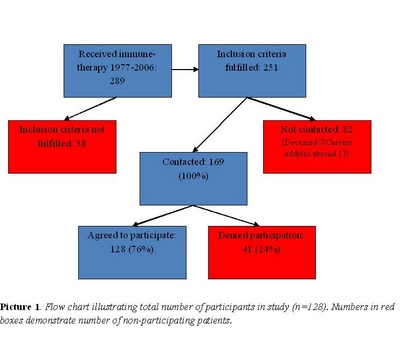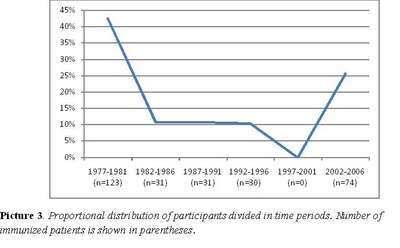07/08. tbl. 96.árg. 2010
Allergen immunotherapy in Iceland 1977-2006
Introduction: The prevelance of allery and asthma has increased rapidly over the last 3 decades and is now estimated that 25-30% of population in Western industrialized countries show symptoms of allergy or asthma. The aim of this study was to reveal the success of allergen immunotherapy (AIT) in Landspitali from 1977-2006.
Material and methods: During the study period a total number of 289 individuals underwent immunotherapy in outpatient clinic of allergy and asthma in Landspítali. A total number of 169 individuals were contacted, of whom 128 (76%) accepted to participate in the study. The evaluation was based on medical records, standardized questionnaire and skin-prick tests.
Results:Patients were evaluated on the average of 20 years after finishing treatment. 118 (92%) patients were desensitized to grass pollen, to birch pollen (30%), cat dander (30%) and dust mite (28%). At the time of the study 67% reported to be asymptomatic or with greatly improved allergy symptoms. Males had better response to AIT than women (p=0.04). Participants with positive family history of allergy and/or asthma in first degree relatives also reported better response to AIT (p=0.02). Furthermore, AIT to grass pollen and dust mite seemed to be more effective than AIT to cat dander and birch (p=0.04). AIT was also shown to reduce asthma.
Conclusion: AIT for 3-5 years provides significant beneficial effect of allergy and asthma symptoms in patients who undergo such therapy. Finally, it´s findings support the notion that AIT may reduce the risk of new allergic manifestations.
Table I. Characteristics of study participants (n=128) who underwent immune vaccination treatment in Landspítali 1977 and 2006.
Male (n=74) Female (n=54)
Years since treatment
ended, n(%):
- less than 2 years: 1 (1,4%) 1 (1,9%)
- 2-5 years: 4 (5,4%) 6 (11,1%)
- 6-10 years: 3 (4,1%) 6 (11,1%)
- 11-15 years: 4 (5,4%) 5 (9,3%)
- 16-20 years: 13 (16,2%) 5 (9,3%)
- More than 20 years: 49 (66,2%) 31 (57,4%)
Average age (years)a: 21,1 ± 8,1 20,7 ± 8,9
Other diseasesb, n(%): 34 (45,9%) 22 (40,7%)
Familial historyc, n(%): 46 (62,2%) 34 (63,0%)
History of smoking, n(%): 23 (31,1%) 24 (44,4%)
a: When treatment started.
b: Other than allergy and asthma. Patients status at follow up.
c: Of allergy and asthma in first degree relatives.
Figure 1.:

Figure 2. Age distribution at the treatment initiation. Total of 289 individuals started immune vaccination therapy against allergen during the study period.
Figure 3.:

Figure 4. Column chart demonstrating numers of participants vaccinated against known allergen. Participants could be vaccinated against more than one allergen. *Dog and horse dander, fish, parrot and wheat.


